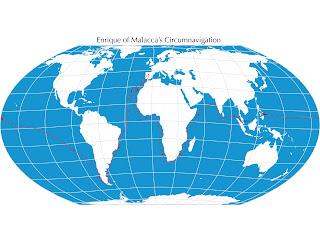 |
| Three- and four-masted carracks. |
The
Nao Concepción was the third-largest
ship in Ferdinand Magellan’s fleet in tonnage. The Concepción was recorded at 90 tons compared
with the
|
Ship |
Tonnage |
Maravedis |
Crew |
|
120 |
330,000 |
55 |
|
|
|
110 |
270,000 |
62 |
|
90 |
228,000 |
44 |
|
|
|
75 |
187,500 |
75 |
|
|
85 |
300,000 |
85 |
The Concepción's Crew
The Concepción started out with a crew of forty-four;
one was added at Tenerefe and at least one more at
In addition to officers, seamen, and apprentice seamen, the Concepción carried a caulker, a carpenter, a cooper, a barber, a blacksmith, and three cabin boys, one of them from Ireland, one from Brazil.
Notable among the Concepción’s crew were its Castilian captain, Gasper de Quesada; its Portuguese pilot, João Lopes Carvalho; and a master of Basque origin named Juan Sebastián Elcano.
Gasper de Quesada
Along with two other captains, Quesada led the
failed Easter mutiny at Puerto San Julian in April 1520. The Concepción was
one of three ships that turned on the
João Lopes Carvalho
João Lopes Carvalho, the Concepción's Portuguese pilot, had crossed the
Atlantic in 1512 and had remained in
During his previous stay in
The Concepción Explores the Magellan Strait
When
the fleet finally found what appeared to be a strait, the Concepción and
the
“We thought that they had been wrecked, first, by reason of the violent storm, and second, because two days had passed and they had not appeared …” wrote Antonio Pigafetta, the expedition's chronicler..
Then
came a dramatic reunion. The Concepción and
The Concepción Survives the First Pacific Crossing
The
Concepción was one of the three ships that made the first Pacific
crossing. Magellan and other explorers had drastically underestimated the size
of the Pacific, and thinking
Days after Magellan’s was killed at Mactan, most the fleet's
remaining officers were massacred in an ambush at
The Concepción Is Scuttled
One
of their first moves after leaving Cebu was to scuttle the Concepción, since they didn’t
have enough crew left to sail three vessels. Carvalho’s former ship
was in the worst condition. They divided the Concepción’s crew and supplies
between the other two vessels and burned to the Concepción off the southwest point of nearby
Carvalho proved to be a poor choice for commander, and he was later replaced. Juan Sebastián
Elcano, originally master aboard the Concepción, became the final captain of the
By John Sailors
Images:
Top: By Frans Huys - This file was donated to Wikimedia Commons as part of a project by the Metropolitan Museum of Art. See the Image and Data Resources Open Access Policy, CC0, https://commons.wikimedia.org/w/index.php?curid=60840737
(C) 2022, by John Sailors.
Was Enrique of Malacca Filipino?
Enrique of Malacca's origin is a subject of debate. Three places are considered possible: Malacca, then a major trade hub on the Malay Peninsula; Sumatra, the large island adjacent to Malacca; and the Visayan Islands in the (modern-day) Philippines. The evidence points to Malacca, though chronicler Antonio Pigafetta said Sumatra, and some scholars believe it's possibly Enrique was from the Visayan Islands in the modern-day Philippines? See the historical evidence in this post: Where was Enrique of Malacca from, Malacca or the Philippines?
- EnriqueOfMalacca.com
- Enrique of Malacca on Twitter
- Enrique of Malacca on Facebook
- John Sailors / Enrique on Medium
- And, yes, Enrique might be 500 years old, but he was known as a kid, so of course he's now on Instagram too.



